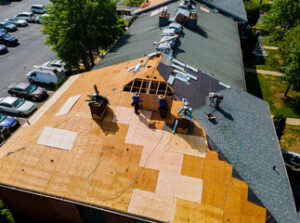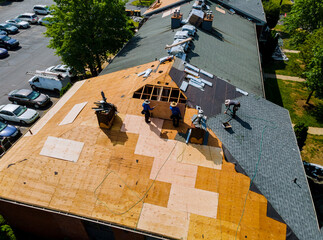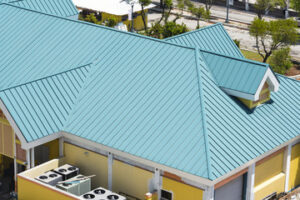The roof protects the rest of your home, so keeping it in good condition is vital. Regular inspections can help to catch minor problems before they become major issues that require a replacement.
Look for brown stains on the ceiling and walls, which are telltale signs of water damage. Also watch for cracks in the flashing around chimneys and vents, which can allow moisture to enter your living spaces. Visit https://www.fivestarroofingandcontracting.com/ to learn more.
The cost of roof repair is a major consideration for homeowners, and it plays a big role in the decision to invest in repairs or replacement. While repairing and replacing are both viable options, the cost of repairs can escalate quickly depending on the extent of damage and the complexity of the work required. The cost of a full roof replacement is significantly higher, but the long-term savings can be significant as well.
The type of roofing materials selected and the extent of damage will impact the overall price of a roof repair project, but other factors can also shape expenses. Labor rates, local demand for contractors, and weather conditions can all contribute to the final costs.
A thorough roof inspection is an essential first step to determining whether a repair or replacement project is needed. Your experienced contractor should be able to identify any problem areas, and recommend the most appropriate repair or replacement solution. They should also be able to offer advice on any potential insurance claims related to the damage, and guide you through every step of the claim process.
Minor repairs, such as replacing a few missing shingles or addressing a small leak, are relatively quick and inexpensive to complete. More extensive issues may include securing gutters or soffits, fixing flashing around chimneys or skylights, or addressing rotted sections of decking or underlayment. These issues can add up to substantial costs if left unaddressed, so it is important to schedule regular roof maintenance and repairs.
Regardless of the scope of the repairs required, your experienced roofing contractor should be able to provide a comprehensive estimate for the entire job, including any associated labor rates. This will give you the peace of mind that the costs of a repair or replacement are not going to balloon unexpectedly, and that the work will be completed in a timely manner.
Ultimately, your roof is one of the most critical components of your home, so it is important to prioritize its upkeep. By working with a reputable contractor and taking advantage of any available financial incentives, you can ensure your home’s roof is in top condition to protect it for years to come.
Repair Options
The level of damage plays an important role in deciding between repair and replacement. If your roof has a small leak in one section or a few missing shingles, repair is a more cost-effective option. On the other hand, extensive wear and tear may be a sign of underlying issues that need to be addressed right away. Ignoring widespread wear and tear can lead to water infiltration, mold growth, or compromised home safety.
A roofing professional will be able to advise you on the best options for your specific situation. For instance, a roof that is nearing the end of its lifespan will need to be replaced as soon as possible to avoid further damage and costly repairs. In this case, replacing the roof with resilient materials will future-proof your home against harsh weather conditions.
Generally speaking, roof repairs are easier to accomplish on gable or hip roofs than on steep-pitched roofs with many angles and custom features. For these types of roofs, it can be difficult to match the original color and texture of the roofing material for a seamless repair. In these cases, a full roof replacement can be the better choice to avoid patchy appearances.
Leaks on flat roofs typically occur in the form of blisters or bubbles that weaken the membrane and cause leaks. A professional roofing contractor will use a special membrane repair product to eliminate the problem by cutting out the affected area and adhering a new piece of flat roofing material in place.
Other common repair methods include resealing and filling depressions on the roof. Depressions allow rain to pool on the roof and can cause structural damage. Depending on the condition of your roof, it may be beneficial to have these depressions filled in with gravel or other non-porous material to help reduce the risk of leaks in the future.
Ultimately, the choice between repair and replacement depends on a variety of factors, including the age of your roof, its overall condition, and how long you plan to live in your home. If you do plan to sell your home in the future, a new roof will enhance its resale value and provide peace of mind that prospective buyers are looking at a well-maintained property.
Materials
The type of roofing material selected for a repair project plays a major role in its longevity. Different materials have unique strengths and weaknesses and react differently to different climatic conditions. Knowing these factors enables homeowners to choose the best material for their homes, and avoid costly mistakes.
Aside from choosing the right roofing repair materials, it is also important to take safety measures into account during roof repairs. These measures help to ensure that workers are protected from dangerous situations and accidents, and reduce the risk of injuries. The most essential protective equipment includes a hard hat, gloves, safety glasses, and non-slip footwear. Safety measures are especially crucial when working on steep sloped roofing surfaces.
The first step in repairing a roof is to locate the source of a leak. This can be done by inspecting the attic or examining the exterior roof surface. Once the leak is identified, it is necessary to clean the area and apply a waterproof sealant. Then, the affected shingles can be replaced and any damaged wood decking can be sealed with plywood or oriented strand board (OSB). Finally, the entire area should be covered with a tarp to prevent rainwater from entering the home until the problem is fixed.
Various materials are available for roof repair, but some of the most common are asphalt shingles and metal sheets. These materials offer cost-effective, low-maintenance solutions to common roofing problems. These options come in a variety of colors and styles, making it easy to find the perfect match for any home design. Other options include cedar shakes, which add natural beauty to a home and last for up to 30 years.
When selecting the best roofing repair materials, it is important to consider the climate and structure of the house. For example, metal sheets may be able to withstand more intense weather elements than asphalt shingles. In addition, the choice of material should be compatible with existing roof components like flashing and underlayment.
Using the right tools and materials will help to ensure that roof repairs are completed quickly and efficiently. In addition, proper application techniques will also contribute to the longevity of the repaired area. This will not only minimize the risk of future leaks, but also maximize the manufacturer’s warranty coverage.
Safety
Roof repairs are a crucial part of home maintenance, and it’s important to take the right safety measures to avoid accidents during the process. By following these simple tips, you can ensure a safe and efficient repair process.
Always wear proper gear and use appropriate tools when working on a roof. This includes slip-resistant shoes, a safety harness, and gloves. Also, be sure to clear the work area of any loose debris before starting. Additionally, be sure to check the area for any power lines and note their location so you don’t accidentally touch them with your hands or hammer. Finally, be sure to choose a dry day to perform the repair work as rain or snow can create dangerous conditions.
If possible, it’s a good idea to cover the damaged area with a tarp while waiting for more permanent repair. This will prevent further water damage and keep your belongings safe from moisture. Make sure to use a high-quality tarp that can withstand harsh weather conditions and wind. It’s also a good idea to inspect the attic for signs of water damage, like stained insulation or wood.
The shingles should be examined for cracks, holes, and missing granules. Missing or cracked shingles can let water in and cause structural damage over time. Make sure to replace these shingles promptly. Also, be sure to check the flashing around chimneys, skylights, and vents for any rust or damage. It’s a good idea to replace these flashings before winter comes, as snow can get trapped under them and cause further damage.
Moss and mold aren’t just unsightly, they can lead to further problems if allowed to grow. Be sure to remove these spores and growths from the roof before they have a chance to spread.
If you notice any of these issues, be sure to call in the professionals for immediate repair and maintenance. This will help you avoid costly damages and repairs in the future. In addition, a professional can help you decide whether the damage is serious enough to require more extensive repair efforts.



 . They may also add features such as ridge vents and gutter systems.
. They may also add features such as ridge vents and gutter systems.